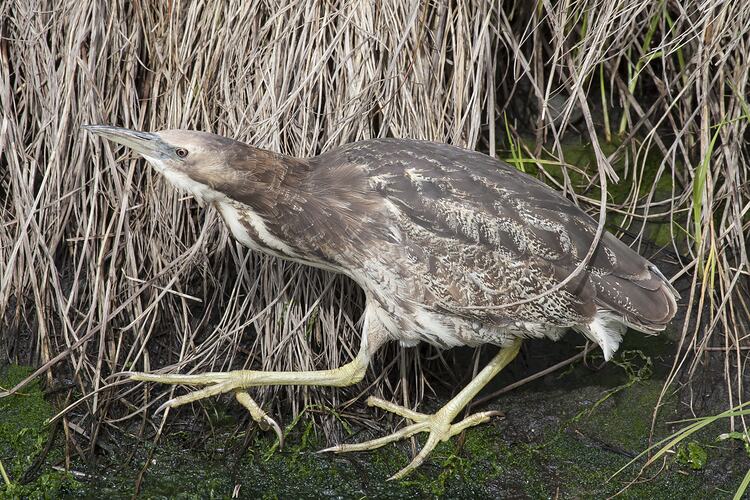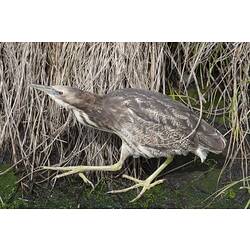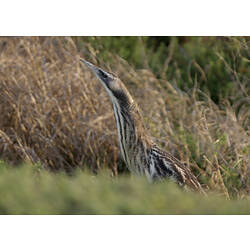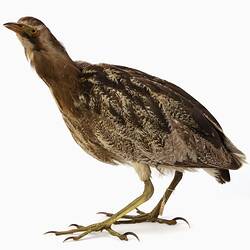General Description
Body mottled and streaked yellow-brown and dark brown. Bill yellow, legs rather short and yellow-green. Body up to 72 cm long. A heavy-set heron-like bird with upperparts patterned dark brown, buff and black, and underparts streaked brown and buff. Eyebrow and throat pale, and the side of the neck dark brown. Legs are greenish. Bill to tail length is up to 76 cm. Call a distinctive booming "woomph" that can be heard at night. Wades with neck outstretched.
Biology
Australasian Bitterns are a partially nocturnal, cryptic, secretive species often heard more than they are seen. They are hard to detect as they live in thick dense beds of rushes and reeds where they are well camouflaged. When alarmed, they stand still with their neck stretched upwards and bill pointing skywards. Sometimes they even sway in the breeze, in time with the surrounding reeds. The position of their eyes low on the head allows them to see forward when their heads are up. They forage mainly at night on small animals including fish, yabbies, frogs, mammals, birds, insects, snails and spiders. Prey is captured using a variety of techniques including active pursuit, slow stalking, standing and waiting, and leg and wing movements which attract or confuse prey. The nest is a shallow saucer made from dry or green reeds found within a clump of reeds in water or a swamp and is built on a platform of bent-over reeds. They breed from September to December with females laying 4-6 green-brown eggs.
Distribution
Coastal and sub-coastal areas in extreme south-western mainland Australia, south-eastern mainland Australia and Tasmania.
Habitat
Wetlands, swamps, reed beds and rice fields. Occasionally saltmarshes.
More Information
-
Animal Type
-
Animal SubType
-
Brief Id
Large, heavy-set heron-like bird, with black and buff streaks and patterns and a pale throat and yellow bill.
-
Colours
Brown, Yellow
-
Maximum Size
72 cm
-
Habitats
-
Diet
Carnivore
-
Diet Categories
Crustaceans, Fish, Insects, Frogs
-
Endemicity
-
Commercial
No
-
Conservation Statuses
CITES: Not listed, FFG Threatened List: Critically Endangered, EPBC Act 1999: Endangered, IUCN Red List: Vulnerable
-
Taxon Name
-
Common Name
Australasian Bittern
-
Kingdom
-
Phylum
-
Subphylum
-
Class
-
Order
-
Family
-
Genus
-
Species Name
poiciloptilus






